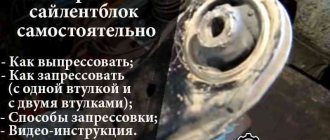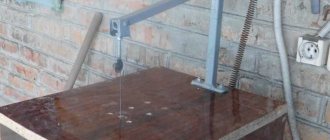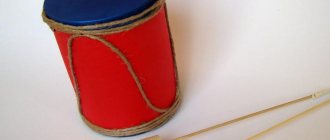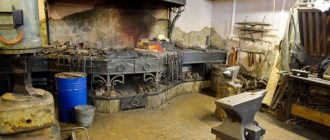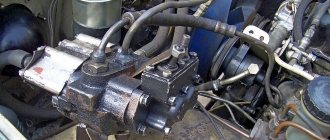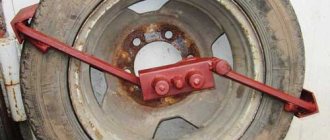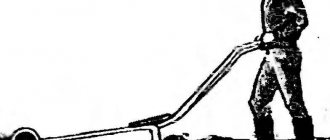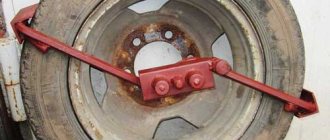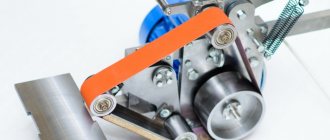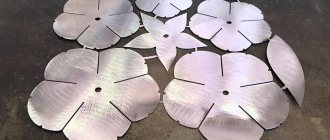Every driver who has the slightest idea about the structure of a vehicle is familiar with such an element as a silent block. Such parts play an important role in a car. With their help, vibrations in various components of the car that arise during its operation are eliminated. And although many motorists consider this part not as important as the same engine or brake system, it is extremely important to monitor it and carry out timely repair work. Otherwise, such carelessness will lead to the fact that the failure of the silent blocks will lead to a breakdown of the mechanism in which it is installed, or even to more serious problems on the car. This useful material will tell you how you can make a silent block remover yourself. About what tools will be needed for this and what subtleties of the process should be taken into account when performing the work.
Using a puller
First of all, I would like to note one important point. The fact is that replacing an element without a puller can damage it and the mechanism as a whole. Often, experienced craftsmen try to nail the inside of the device using a hammer. But often such manipulation leads to the fact that the part fits unevenly and its internal part begins to be damaged over time. The solution to this problem is the use of a hydraulic silent block puller, which helps connect the two parts of the device in such a way as to prevent damage. In this case, the puller circuit is based on the use of a long threaded device to unscrew and screw in the element. This allows for uniform lowering and raising of the inside of the part. As for doing the work of making a puller with your own hands, in this matter significant attention should be given to familiarizing yourself with the diagram. You can also look at the designs of ready-made pullers, which can be found in any automotive store.
Do-it-yourself hydraulic silent block presser
The hydraulic press has a multi-purpose purpose.
This device serves mainly to compress objects of high and medium density while changing their shape or displacing the liquid that is included in the composition.
In addition, the equipment can also be used to carry heavy objects, but there is no need to buy a hydraulic press, because you can do it yourself using a regular jack.
Operating principle of a hydraulic press
Making a press from a jack with your own hands does not affect its quality and technical performance.
The characteristics are equal to the equipment that is produced in production.
A hydraulic press can be used at home for many purposes. These include:
- stamping;
- forging;
- arching;
- extrusion of profiles;
- pressing of various objects.
In addition, pressing can be used for packaging various items made of wood, metal and plastic.
A hydraulic press is used in almost any industry, but it also finds its application in everyday life.
The advantage of such equipment is the law of hydrostatics, which, in turn, facilitates the pressing of objects with any density.
The principle of operation is that a hydraulic press presses on one specific point and thereby increases efficiency elsewhere on the object.
Thus, it is possible to perform a variety of actions from bending to pressing an object with minimal effort.
The entire design includes a small number of parts, but the main ones are two piston cylinders, which differ from each other in their diameter.
Inside the pistons there is ordinary water or oil. The liquid allows the law of hydrostatics to operate.
This allows you to increase the efficiency and the object will already be subject to a force of several tons.
The structure of a hydraulic press involves working in two planes , but most often a vertical type of equipment is used, and less often a horizontal model.
Making a press with your own hands
Today, there are quite a large number of drawings that allow you to make a hydraulic press using a jack with your own hands.
A homemade press will not differ from real equipment produced at the enterprise.
As a result, you can save money and get high-quality equipment at your disposal, which is also easy to improve and modify in the future.
In everyday life, a homemade press can be used for pressing various kinds of objects, including waste that remains after metal processing.
Many craftsmen especially often use a press to deform pipes and bend profiles .
Since a hydraulic press is created for domestic purposes with your own hands, you can use an ordinary garage instead of a workshop.
Required Tools
Assembling a homemade press using only your own strength is quite simple, but you need to prepare all the necessary tools in advance.
It is imperative to prepare a welding machine and a large number of electrodes. If you don’t have welding skills, you can ask specialists to help for a small fee.
metal profiles are used as the main raw material , which can be purchased on any construction market. There is no point in buying a large quantity at once. It's better to buy everything as needed.
Pressure can also be supplied to the working cylinder by installing a hydraulic jack, which already has a built-in manual pump.
Jacks can be very different, but it is better to choose a bottle-type model, since they have shown the longest service life over the entire period of use.
When starting to assemble a hydraulic press, you need to pay attention to the fact that the jack is installed exclusively in a vertical position and it is not allowed to push the jack rod down.
To use a hydraulic press at home, a minimum load force of 10–20 tons . Large load force, used only when working in production. It is also important to pay attention to such characteristics as:
- bed parameters;
- piston stroke;
- weight;
- dimensions.
The pressure inside the cylinder is obtained using a manual or hydraulic pump. The second option simplifies the work, but the hand pump can be easily replaced.
Creating the basis for a homemade press from a jack
The beginning of work on creating a homemade press is based on creating a platform that will serve as a support and can at the same time withstand the load of the press.
It must be taken into account that the force that will act during pressing must be proportional to the nodes.
In fact, the jack will try in every possible way to break the frame structure , so its strength is the key to the quality of all equipment.
It is necessary to make a frame that would withstand a load greater than the force acting during operation of the hydraulic press.
The frame opening must correspond in size to the intended material that will be used during pressing, so it is important to determine the width of this part at the stage of its creation.
The minimum width dimensions have their limits, because it cannot be less than the total dimensions of the press.
When determining the exact height of a hydraulic press, it is necessary to take into account the length of the jack, the free amplitude of the rod, the free space for processing materials and the dimensions of the work table.
How to make a silent block remover yourself
Let us immediately note that replacing silent blocks without a puller is fraught with damage to the mechanism parts. Very smart craftsmen resort to hammering the inside of the device, but this leads to the fact that the uneven fit of the inside can be damaged.
A hydraulic silent block remover allows you to disconnect one part of the device from another without damaging them.
Its operation scheme is based on unscrewing or screwing in a special long device with a thread, which will evenly lower or raise the inner part.
This process is called pressing and the smoother and more uniform it is, the longer the service life of the device.
How to make a puller: manufacturing instructions
Using a puller, you can quickly and easily remove and press in silent blocks. To manufacture such a convenient part, you do not need an enormous amount of knowledge and skills. The work of making a puller is not particularly difficult and can be done by any motorist if desired. The main thing for this is to take the right tool:
- Keys and screwdrivers;
- A piece of strong metal pipe with a diameter slightly larger than the silent block;
- Steel washers;
- Long threaded bolt;
- Overalls and gloves.
First, you need to thoroughly study the car suspension and decide how best to use the puller. Next, a silent block should be inserted into part of the pipe on one side, and a new mechanism on the other. Direct the silent block into the seat, take the bolt and screw it to the center.
More details about the manufacture of a silent block remover will be discussed in this video:
Auto repair shop specialists and ordinary car enthusiasts know how important it is to have all the necessary tools on hand when servicing a vehicle.
Despite the fact that the time of independently “digging” in the car has almost passed, many car owners still perform basic tasks on their own.
For example, for experienced car enthusiasts it will not be difficult to replace silent blocks, but in order for this process to go without a hitch, it is better to purchase a special puller in advance.
How to choose the specified tool, what to look for and which popular models to pay attention to today - read below.
What is a silent block
This word is of foreign origin. Translated from English, silent means silence, and block means detail. A silent block, or simply “silent,” is a rubber-metal component; in ordinary words, these are two bushings that are connected to each other by a layer of durable rubber. This invention, in addition to guaranteeing comfortable and silent movement in a car, has a number of advantages that will be listed below.
Purpose and functions
Silent blocks perform the following functions:
- Protect components from wear and tear by damping vibrations .
- They dampen vibrations that come from the chassis of the wheels, thus providing a comfortable and soft ride.
- Prevent vibrations and beatings that appear during the movement of the car between different elements of the chassis and engine compartment.
And these are just the main advantages; in fact, there are many more.
How to choose
Of course, before moving on to choosing a specific puller for the front or rear silent blocks, you first need to understand what kind of device it is and what it is used for.
Read also: How to make a stationary one from a hand router
Appearance
There can be a wide variety of such tools, because today they are presented both as a separate C-shaped device with several attachments, and as whole sets, which include guide pins with nuts, sleeves and support disks for them.
There are also universal pullers and those designed for a specific car brand , which must be taken into account when purchasing.
A correctly selected product will help you easily cope with difficult work, since the silent block is quite firmly fixed in its seat and sometimes it takes a lot of effort to remove it.
Depending on the type of part (whether it is an element of the front suspension, stabilizers or fastening of torque rods) installed on a car or truck, a puller for removing silent blocks - elements that reduce rattling and noise when the vehicle is moving - will have its own characteristics.
Among the wide variety of domestic and foreign tools presented on modern markets, you can find absolutely any puller that will meet all the technical parameters of your machine and individual requirements (for example, cost).
However, the main task in any case remains the choice of a quality product that will serve faithfully for many years. Therefore, now we invite you to familiarize yourself with the list of characteristics that are worth paying attention to, and the list of features that are unworthy of it.
What to look for:
So, when choosing a silent block remover for VAZ cars or foreign cars, you should consider the following:
- the model of your car, unless, of course, you decide to buy a universal tool (by the way, there is an opinion that specialized products are much more durable than universal pullers, but in practice it all depends on the manufacturer);
- the presence of smooth edges in all threaded connections of special tools;
- absence of rough areas and open shells;
- ease of unscrewing and tightening detachable parts;
- the requirements of the selected model for other, additional tools, without which it cannot be operated;
- type of puller: manual or hydraulic (for personal use or for car maintenance in small workshops, the first option will be sufficient);
- Availability of instructions in a language you understand.
Sellers can assure you that the same instructions are not so important, because the mechanism of the tool is extremely simple and easy to use, but you must understand that when delivering quality products, such a trifle cannot be a problem.
What you can ignore:
In addition to the indicated important criteria for choosing a silent block remover (both universal and for specific vehicle models), there are also several less significant nuances that can often be regarded as a regular advertising ploy. These include:
- a list of functions that almost all models perform: easy removal of silent blocks, long service life, etc.;
- the relationship between price and quality (despite the fact that many people associate these two indicators, more well-known companies may unreasonably inflate the prices of their tools, and with a more careful study of the offers on the market, you can find a puller with the same characteristics, but at a more affordable price) .
Acceptable breakdowns, troubleshooting
The front suspension device is a complex design. If knocking or extraneous noise occurs, its condition should be checked and diagnosed to prevent unexpected breakdowns.
The problem is noise and knocking from the bottom of the car while driving
Causes and solution to the problem:
- shock absorber failure. The GAZ-31105 suspension uses a collapsible shock absorber, so it can be replaced or repaired;
- deterioration of rubber seals used to connect some elements, as a result of which periodic knocking will be heard in the trunk area. Worn rubber bands need to be replaced.
Helpful advice! The price of these rubber elements is low. Therefore, it is recommended to buy the entire set of pillows and replace them completely.
- deterioration of the hinge of the levers - replace them with new ones;
- the ball joint is worn out (the stabilizer strut joint is broken). Replacement of racks along with hinges is required;
- wear of the ball joints of the lever - replacement of the joints;
- large gap in wheel bearings - gap adjustment, bearing replacement;
- sifting, broken spring arc - replacing the old spring with a new one.
Source
Licota ATC-2286
The set of silent block pullers is equipped with mandrels and cups of the most popular sizes, which are excellent for working with parts of domestic and foreign production.
Before using the puller, you only need to select a mandrel of the required size, install it on the element to be removed and perform dismantling by rotating the nut. Using the kit, the entire silent block removal process is quick and easy.
Read also: How to connect four light bulbs from one switch
Characteristics:
- It is used for both pressing out and pressing in silent blocks.
- Internal mandrels: 34, 36, 38 – 70, 72, 75, 80 mm.
- Outer mandrels: 44, 46, 48 – 80, 82, 85, 90 mm.
- Pins: M10, M12, M14, M16, M18.
- Type: universal puller.
- Weight: 17 kg.
Pros:
- It has different attachments, making it suitable for different brands of vehicles.
- All parts are easy to assemble and disassemble.
- Possibility of dismantling and installing silent blocks.
- Convenient case for storing all puller parts.
Minuses:
- Relatively heavy weight.
- High price.
Types of presses
A garage press typically uses a manual drive. In other words, the design of the press uses a manual or manual hydraulic pump, which is matched to the power cylinder according to the volume of oil.
A hydraulic press consists of two chambers with pistons connected to each other by an oil line. The operating principle of a hydraulic press is based on Pascal's law. That is, the pressure force on the workpiece is as many times greater than the force applied to the piston, how many times the area of the piston is greater than the area on which the press rod acts.
MASTAK 110-20026C
Another good option made in Taiwan. This impressive set consists of 26 elements, which allow it to be used to remove a wide variety of silent blocks and bearing races.
Characteristics:
- Availability of 20 mandrels with ø 44/34 (11 pieces) and ø 48/38 (9 pieces).
- The set also includes thrust washers (2 pieces) and 350 mm power bolts (M16x2.5, M14x2.0, M12x2.0, M10x1.5).
- Type: universal tool.
- Weight: 18 kg.
Pros:
- High-strength material for all parts.
- Possibility of universal use (suitable for various brands of cars).
- Suitable not only for silent blocks, but also for external and internal races of bearings.
- Convenient storage case.
Minuses:
- Price.
- The latches on the case do not always fit tightly.
- Weight.
Permissible rear suspension breakdowns, repairs
While driving on an uneven road, noise, creaking or knocking is heard from the lower rear part, which means it’s time to check the condition of the GAZ-31105 suspension.
The problem is extraneous noise and knocking when driving
Causes and solution to the problem:
- shock absorber malfunction. The rear shock absorbers are dismountable, so if you hear a knock during their operation, you can try to repair it yourself;
- production of rubberized spring gaskets - replacement of gaskets;
- rubber gaskets connecting the rod and side members have collapsed - replace the gaskets;
- the rod hinge is worn out, the connection is weak - replace the rod or tighten the connection;
- the shock absorber is loose in the brackets or the sealing pads and bushings are broken. It is necessary to tighten the shock absorber fastenings or replace worn elements.
Rear suspension device of Volga 31105
Springs squeak when loaded
- the cushions between the leaf springs or under the bushings have collapsed - replacing worn cushions;
- noticeable tilt of the machine;
- subsidence or destruction of leaf springs - replacing the entire spring or only the damaged leaf.
The front wheel track does not match the rear one
- the main leaf has become unusable - replacement of a spring or one main GAZ-31105 vehicle;
- The central bolt holding the leaf springs together is broken - replace the bolt.
Sudden and frequent dips when driving on dirt roads
- one of the springs has settled, broken - replace, repair the spring;
- The car was operated for a long time with an overloaded interior and trunk - replacing a faulty spring.
During breakdowns a metallic knock is heard
- shock absorbers have lost their compression effect - replacement, repair of shock absorbers;
- rubber buffers are destroyed - replacement of rubber buffers.
FORCE 949T1
The model belongs to the hydraulic puller type, the set of which includes 49 items. With its help, you can easily disassemble the bushing and replace it (with the exception of parts without holes). Compared to the above puller options, FORCE 949T1 is lighter and easier to use.
Characteristics:
- The maximum load on the cylinder is 18.2 t.
- The comfortable and durable spindle has dimensions: Ø 16 mm, Ø 14 mm, Ø 12 mm, Ø 10 mm.
- Deep mandrels - 22 pieces (18 internal ones of 110 mm each and 26 external ones of 68 mm each).
- Short mandrels - 22 pieces (18 internal 40 mm and 26 external 68 mm).
- Bolts - 4 pieces (diameter 16, 14, 12, 10 mm).
- Type - hydraulic universal puller.
Pros:
- Convenient collars.
- Sturdy case with metal clasps.
- Strong ratchets.
- Long heads.
- The handles are made of high-quality material that is not corroded by technical liquids.
Minuses:
- All parts of the puller are sensitive to moisture and quickly rust when exposed to it.
- High price.
Suspension for GAZ-31105
One of the main advantages of the GAZ-31105 is its pinless suspension. The difference between this design is improved endurance. Noise and knocking while driving will no longer annoy the driver and passengers of this car so often. In addition, there is now no need to periodically inject the system, and the repair and operation of the Volga 31105 has become noticeably simpler and more convenient.
Side view of the GAZ 31105 car
JTC 1-4091
A universal kit for removing and installing silent blocks is an ideal tool for vehicle maintenance.
It includes 11 items that, in addition to the parts already mentioned, are suitable for installing and dismounting bushings or bearings (including those with a rubber bushing).
Characteristics:
- The inner diameter of the sleeves (20 pieces) is 34 – 72 mm in increments of 2 mm.
- Support discs used together with liners - 2 pieces.
- Bolts with a length of 450 mm - M16, M14, M12, M10.
- The weight of the set is 3.3 kg.
Pros:
- All elements are made of high strength steel.
- Supplied in a durable case, making it easy to care for and transport the set parts.
- Relatively light weight.
- Case strength.
Cons: No socket or ratchet to make the job easier.
Quite a lot of car enthusiasts are interested in how to make a silent block remover with their own hands. After all, these vibration-reducing suspension elements have to be changed quite often. Moreover, this applies not only to domestic cars, but also to many foreign cars. The problem is related to the poor quality of roads. A sporty driving style also negatively affects the technical condition of silent blocks as part of the suspension. Incorrect installation will not extend the service life.
Read also: How to change the pressure gauge at a pumping station
Many mechanics hammer the silent block with a hammer. In this case, the rubber is damaged and the metal bushing may become dislodged. Therefore, always use pullers; as a last resort, there are completely harmless methods to put the part in place without the help of specialized tools. We will talk about this at the end of the article.
How to make a silent block remover with your own hands? Before answering this question, it is advisable to understand what a silent block is. This will make it easier to make a puller.
A silent block is a rubber-metal joint that is capable of dampening vibrations that occur in the suspension. On passenger cars, a part made in the form of a metal bushing with an elastomer body is more common. The most common option for making a hinge is regular rubber. But polypropylene hinges can be called the most durable and high-quality. It is recommended to purchase exactly these when replacing.
Do-it-yourself pressing and pressing of silent blocks: description of work, materials and methods
Everyone who has a car is familiar with the problem when there is a need to press out or press in silent blocks. You don’t always want to turn to specialists, and doing it yourself is much more pleasant.
Thanks to this article, you will learn what silent blocks are, why they are needed, and most importantly, how to press them in and press them out at home using different methods.
This word is of foreign origin. Translated from English, silent means silence, and block means detail.
A silent block, or simply “silent,” is a rubber-metal component; in ordinary words, these are two bushings that are connected to each other by a layer of durable rubber.
This invention, in addition to guaranteeing comfortable and silent movement in a car, has a number of advantages that will be listed below.
Purpose and functions
Silent blocks perform the following functions:
- Protect components from wear and tear by damping vibrations .
- They dampen vibrations that come from the chassis of the wheels, thus providing a comfortable and soft ride.
- Prevent vibrations and beatings that appear during the movement of the car between different elements of the chassis and engine compartment.
And these are just the main advantages; in fact, there are many more.
How to understand when it's time to replace
Before you set out to press in these parts, you should first of all inspect them thoroughly to make sure that they really require replacement. Check for holes and any deformations, for swollen rubber on the hinges and for cracks.
Manipulate the components, determining the presence of backlashes. If the permissible norm is exceeded, then replacement of parts is inevitable. It is not recommended to delay the pressing procedure.
Over time, this problem will only get worse and can lead to suspension arm failure.
The main indicators that indicate the failure of one part or several:
- Driving the car has become much more difficult.
- When overcoming bumps, the suspension begins to knock loudly. Tires wear unevenly, which has not been observed before.
- It has become much more difficult to adjust wheel alignment.
To press this part into place at home, you will need the following tools:
- Mount;
- Jack;
- Set of wrenches;
- New hinges.
It is recommended to use machine oil or other types of lubricant as a lubricant.
Among other things, you will need special mandrels designed for pressing silent blocks; as an alternative, you can use a piece of pipe with the required diameter.
You also need to get a press to press in a new rubber-metal hinge . When it comes to home use, an ordinary vice can serve as a press.
In addition, you can stock up on a set of sledgehammers, but with this approach it is necessary to maintain high precision in the work.
Pressing out at home
Replacing these parts is not as difficult as it might seem at first glance. For example, many car owners made sure of this when they replaced parts, using special equipment for self-replacement. It is for this reason that there are many people who have decided to replace silent blocks with their own hands and at home.
First method
First of all, let's learn about how it should be ideally.
The lever in which the rubber-metal hinge needs to be replaced is installed on a special spacer for the press. The old silent will be squeezed onto this spacer. Then another spacer is installed on top - it squeezes out the old bushing. This method is used by service station workers, since they have the necessary set of spacers and a powerful press of 10-20 tons.
Second method
Almost all car owners, naturally, do not have a powerful press, but many have a jack or a good vice in their garage. If you use a powerful vice, you can successfully squeeze out the old bushings according to the principle that is already familiar to us: a spacer for the original bushing and a spacer for pressing on the bushing.
At first glance, it becomes unclear how you can squeeze out the silent tape with a jack? Everything is very simple: you need to weld a frame in the shape of a rectangle from a channel or corner so that its height is slightly higher than the lever and the jack.
The operating principle is as follows: place the jack in the frame, then install the lever eye on top of the rod, as well as the two spacers mentioned above. We create the required pressure, after which the bushing is squeezed out of its seat.
It must be emphasized that most often a jack with a capacity of 3-5 tons is not able to cope with such work, therefore it is recommended to use 10-ton jacks.
Third method
If you have neither a press nor a jack, but still have a strong desire to replace the silent blocks on your own, you can use the third method - using a simple press puller (bolt with nut or stud).
The principle of operation is to create pressure by gradually tightening the nut on the stud; this method can be called an analogue of a vice.
This pin with a washer of suitable diameter is inserted into the eye through the silent block, then on the other side you should put on a spacer with a washer and tighten the nut.
Rotating along the thread, the nut creates the necessary pressure and forces the silent to be squeezed into a special spacer.
This “method” requires the use of a strong, hardened stud and an equally strong nut. If you take a soft pin or nut, you will most likely fail.
For example, there are cases when, due to strong pressure, the stud becomes bent, as a result of which the thread on the nut breaks. However, there are thousands of those who managed to change silent blocks using this particular method.
After all, everything depends on the quality and strength of the material used.
The advantage of this method is its low cost, as well as its convenience, if you look at it from the “mobility” point of view. In other words, you don’t need, for example, to completely remove the lever or the entire hub; it will be enough to just have a simple press puller like this.
Fourth method
This method can be classified as drastic decisions or extreme measures. Its principle is to use all popular methods and devices to extract silent from the seat. To do this, you need to knock out the old part using a powerful screwdriver or a thick wedge-shaped piece of reinforcement.
You need to try to hammer a screwdriver or something between the silent block and the bushing, thus deforming the wall of the bushing inside. Now that the bushing is crushed and pushed inward, it is not at all difficult to knock it out.
Before you start knocking out the silent block, you need to squeeze out or burn out the inner sleeve of the part and, if possible, all remaining rubber.
Fifth method
The next method of removing a silent block cannot be called pressing out, since it, like the previous one, does not require the presence of a press: all you need is a metal blade, a hammer and a screwdriver. The principle is simple, but unsafe.
We remove the inner sleeve, then take the blade and start cutting the outer sleeve. Try to cut through the old silent as much as possible without damaging the lever itself or the eye.
It is best to make two cuts, and then using a flat screwdriver, the silent block will be easily deformed and knocked out.
If none of the methods listed above helped, and you still need to do it, there is only one option left - to entrust this work to specialists. To achieve the desired result, take the part and go to the service station, where specialists, using a silent block extractor and other special tools, will qualitatively do all the necessary work “in the blink of an eye.”
We have already talked in detail about how to get the “silents”, now another problem arises - how to press this part? This procedure is difficult because it requires certain skills and abilities. An incorrectly or crookedly installed silent will either not work or break prematurely.
Necessary materials
To press this part at home, you will need the following tools:
- Scrap;
- Jack;
- A set of keys;
- The hinges are new.
It is recommended to use machine oil or other types of lubricant as a lubricant.
By the way, you will need special mandrels designed for pressing into silent blocks; as an alternative, you can use a piece of pipe of the required diameter. You will also need a press to insert the new metal zipper. At home, an ordinary vice can act as a press. In addition, you can stock up on a number of maces, but with this approach it is necessary to maintain high precision in the work.
Homemade devices
Of course, a special device for pressing silent blocks costs some money. But what to do if there is no money to purchase such a device? There is only one answer - use homemade tools for these purposes or improvised pressing methods.
The simplest, but at the same time effective devices for pressing in hinges, which are within walking distance, are as follows:
- Ordinary vice. They can be used if the part into which the hinge is pressed is not too bulky and can fit between the two compressive surfaces of the vice. The principle of their action is simple and based on compression. For pressing, it is necessary to lubricate the contacting surfaces and place them in a vice so that when the vice is twisted, the silent block is pressed into its seat. When carrying out this procedure, it is important to act carefully so as not to damage either the part or the hinge itself.
- Hammer . Let us note right away that this method is extremely risky and not always safe to use. Despite this, it is often used in makeshift garage repair conditions. Pressing the silent block in with a hammer is not difficult, the main thing is to carefully, using this tool, drive the hinge into its seat. Don't forget to use lubricant.
- Homemade devices. You will have to make these tools yourself. The principle of their operation is similar to that inherent in special devices from the store. However, it is worth understanding that the manufacture of such tools may require turning, cooking skills and special equipment. The simplest devices can be made according to the images below:
As you can see, the tool for pressing out and pressing in silent blocks is represented by a fairly wide range of devices. Which one is better will be chosen by each repairman individually. We hope the material presented above was useful to you. Good luck with the repair and on the road!
Using a sledgehammer
It is enough to select a piece of pipe or make a glass to match the outer diameter of the silent block. First, use WD fluid to spray the joint between the silent block and the spring eye. Then one person holds the glass against the silent block, and the other person hits the glass with a sledgehammer. The pressing procedure is simple; the silent block is driven into the eyelet.
Plus: the cheapest way.
Disadvantage: high labor costs. Two people required. The operation takes a very long time. There is a high risk of injury to a person and damage to the spring eye, and during pressing, to the silent block. For these reasons, this method is practically not used, with the exception of emergency repairs on the highway.
